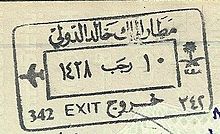
Back Almanak Islam ACE Islamitiese kalender AF Islamische Zeitrechnung ALS تقويم هجري Arabic تقويم إسلامي ARY تقويم هجرى ARZ ইছলামিক বৰ্ষপঞ্জী AS Calendariu islámicu AST Исламияб календарь AV हिजरी AWA
| Today | |
|---|---|
| Friday | |
| Gregorian calendar | January 10, 2025 |
| Islamic calendar | 10 Rajab, 1446 AH |
| Hebrew calendar | 10 Tevet, AM 5785 |
| Coptic calendar | Tobi 2, 1741 AM |
| Solar Hijri calendar | 21 Dey, 1403 SH |
| Bengali calendar | Poush 27, 1431 BS |
| Julian calendar | 28 December 2024 |
| Byzantine calendar | 10 January 7533 |
| Part of a series on |
| Islam |
|---|
 |

The Hijri calendar (Arabic: ٱلتَّقْوِيم ٱلْهِجْرِيّ, romanized: al-taqwīm al-hijrī), or Arabic calendar, also known in English as the Muslim calendar and Islamic calendar, is a lunar calendar consisting of 12 lunar months in a year of 354 or 355 days. It is used to determine the proper days of Islamic holidays and rituals, such as the annual fasting and the annual season for the great pilgrimage. In almost all countries where the predominant religion is Islam, the civil calendar is the Gregorian calendar, with Syriac month-names used in the Levant and Mesopotamia (Iraq, Syria, Jordan, Lebanon and Palestine), but the religious calendar is the Hijri one.
This calendar enumerates the Hijri era, whose epoch was established as the Islamic New Year in 622 CE.[1] During that year, Muhammad and his followers migrated from Mecca to Medina and established the first Muslim community (ummah), an event commemorated as the Hijrah. In the West, dates in this era are usually denoted AH (Latin: Anno Hegirae, lit. 'In the year of the Hijrah').[a] In Muslim countries, it is also sometimes denoted as H[2] from its Arabic form (سَنَة هِجْرِيَّة, abbreviated ھ). In English, years prior to the Hijra are denoted as BH ("Before the Hijra").[3]
Since 7 July 2024 CE, the current Islamic year is 1446 AH. In the Gregorian calendar reckoning, 1446 AH runs from 7 July 2024 to approximately 26 June 2025.[4][5][b]
- ^ Paul Lunde. "The Beginning of Hijri calendar". Saudi Aramco World Magazine. No. November/December 2005. Archived from the original on 1 January 2019. Retrieved 1 January 2019.
- ^ Watt, W. Montgomery. "Hidjra". In P.J. Bearman; Th. Bianquis; C.E. Bosworth; E. van Donzel; W.P. Heinrichs (eds.). Encyclopaedia of Islam Online. Brill Academic Publishers. ISSN 1573-3912.
- ^ "Hijri Calendar". Government of Sharjah. Archived from the original on 2 February 2017. Retrieved 21 January 2017..
- ^ "Important dates in Islamic Calendar in the Year 2024". Al-Habib.info. Retrieved 1 October 2023.
- ^ "Important dates in Islamic Calendar in the Year 2025". Al-Habib.info. Retrieved 8 July 2024.
Cite error: There are <ref group=lower-alpha> tags or {{efn}} templates on this page, but the references will not show without a {{reflist|group=lower-alpha}} template or {{notelist}} template (see the help page).